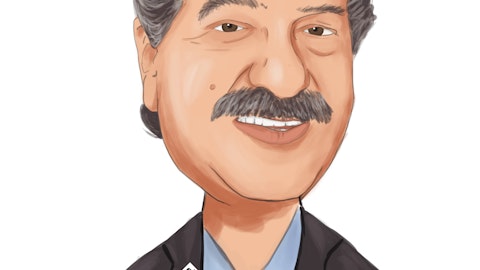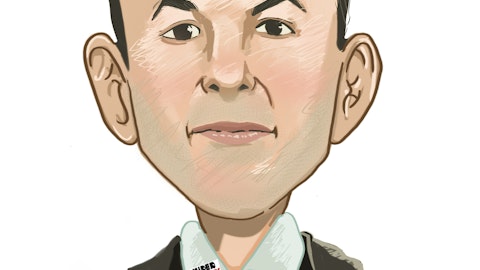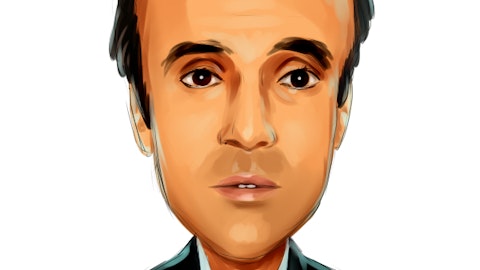Michelle Brukwicki: Yeah. And, Simon, on the TDS Telecom side, very similar story. We have about 19,000 customers enrolled in ACP, and we too are following the SEC’s direction in terms of winding down that program. We’re working with all of those customers in order to try to find the right broadband product for them. There might be a little exposure there to customers who may not land with us. But we actually also see this as an opportunity. There’s ACP customers of other companies that might be looking for a new provider and we’d be happy to serve them. And we’ve got efforts in place to try to attract those customers. So impacts would be minimal and anything is included in our guidance.
Simon Flannery: Great. That’s very helpful. And then on the wireless affiliates, just looking at the guidance, it seems like the expectation is for fairly similar contribution to EBITDA in ’24 versus ’23. Is that right? And any comments on the trends there or any growth expectations on that?
Douglas Chambers: Yeah. You’re exactly right, Simon. We’re expecting that to be relatively flat in ’24 relative to what you saw in ’23, so no significant changes there. And obviously, we don’t directly control those entities or the distributions, but our expectation is pretty flat.
Simon Flannery: Great. And then there’s the last one on the BEAD timing. I know, LT, you talked about the program on the 5G. In working with your states, I know we’re going through sort of challenge processes and so forth. But what’s your latest view on when we’ll actually see actual awards take place and when we’ll know more about the FWA role and so forth?
Laurent Therivel: I think dollars, Simon, will probably start to flow late this year. I think the majority of dollars will probably start coming in in 2025. I also expect to have a bit of a — call it a sequenced, or you could call it a take two on funding plans. My expectation is that states will first come out with quite aggressive plans in terms of expectations of fiber build out, expectations of low cost pricing plans, expectations of a whole bunch of other, let’s call it overhead associated with those plans. It’ll be interesting to see how much uptake they get, right? Is this — is round one of BEAD going to be a tremendous success or is round one of BEAD going to be all over again? I think that’s a question that still needs to be answered.
Based on our conversations, I still feel quite optimistic about the long-term role of fixed wireless that we can play, particularly for our more rural states. It’s unclear to me if that will be kind of part of the first round with some of the states that we’re talking about or if it’s going to be later. But I wouldn’t expect meaningful dollars to flow until next year.
Simon Flannery: Great. Thanks a lot.
Colleen Thompson: Okay. Next question.
Operator: Our next question comes from Michael Rollins from Citi. Please go ahead. Your line is open.
Michael Rollins: Thanks, and good morning. Just following up on the BEAD topic. When you look at UScellular as well as TDS, can you frame the type of financial capacity you have to go after BEAD opportunities? And if there are significant wins, how does that influence capital allocation for each side or both? Thank you.
Michelle Brukwicki: Doug, do you want me to take that first for TDS?
Douglas Chambers: Sure. Go ahead, Michelle.
Michelle Brukwicki: Yeah. So, hi, Mike. For TDS Telecom, there’s an important distinction here. So there are the two federal broadband programs. The first one is the enhanced ACAM program and the second one is BEAD. And it’s our understanding that if addresses are under the enhanced ACAM program, which we opted into in almost all of our states, those addresses also cannot be funded by BEAD. Which makes sense that you wouldn’t have two federal programs funding the same addresses. So because we’ve opted to be a large participant in the E-ACAM program, at TDS Telecom, we actually don’t plan to be a BEAD participant. So for capital allocation, our — our competing priorities are fiber expansion program and the enhanced ACAM program, and BEAD does not enter into that equation in any significant way.
Laurent Therivel: So, let me tackle it from a fixed wireless perspective, Mike. So first — the first place I would point to is where there are going to be BEAD opportunities that can be served within the radius of our current tower build. Where we can do that, it’s a pretty simple equation. We utilize existing mobile capacity. We — we’d leverage that capacity towards serving a fixed wireless need. And if we can do that with the support of BEAD dollars, all the better. And so for those homes and businesses, we think we have a really compelling return on capital equation that comes along with that. What percentage of those are going to be, I have no clue. Right, we kind of have to wait and see what the — what the states come out with.
There’s a second set of homes, obviously, that are not currently reached by either fiber or by a sufficiently strong enough mobile signal that we can deliver a compelling fixed wireless product. And for that, you need to put a new tower in. The reason that we’ve advocated for BEAD is — and the reason, I’ll go back to our sequencing point that I made earlier, I expect that BEAD will create a significantly denser fiber grid, completely irrespective of fixed wireless. So that will bring our overall cost down to serve. And if I can — I’ve mentioned this number before, but our cost to put a tower in rural America is between $650,000 to $1 million. If with BEAD dollars, I can bring that down to $100,000 or $200,000, then that could create a pretty compelling investment opportunity.





